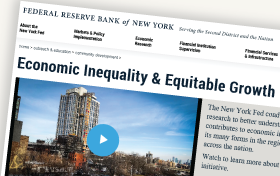How Competitive are U.S. Treasury Repo Markets?
The Treasury repo market is at the center of the U.S. financial system, serving as a source of secured funding as well as providing liquidity for Treasuries in the secondary market. Recently, results published by the Bank for International Settlements (BIS) raised concerns that the repo market may be dominated by as few as four banks. In this post, we show that the secured funding portion of the repo market is competitive by demonstrating that trading is not concentrated overall and explaining how the pricing of inter-dealer repo trades is available to a wide-range of market participants. By extension, rate-indexes based on repo trades, such as SOFR, reflect a deep market with a broad set of participants.
Up on Main Street

The Main Street Lending Program was the last of the facilities launched by the Fed and Treasury to support the flow of credit during the COVID-19 pandemic of 2020-21. The others primarily targeted Wall Street borrowers; Main Street was for smaller firms that rely more on banks for credit. It was a complicated program that worked by purchasing loans and sharing risk with lenders. Despite its delayed launch, Main Street purchased more debt than any other facility and was accelerating when it closed in January 2021. This post first locates Main Street in the constellation of COVID-19 credit programs, then looks in detail at its design and usage with an eye toward any future programs.
How Does the Liquidity of New Treasury Securities Evolve?
In a recent Liberty Street Economics post, we showed that the newly reintroduced 20-year bond trades less than other on-the-run Treasury securities and has similar liquidity to that of the more interest‑rate‑sensitive 30-year bond. Is it common for newly introduced securities to trade less and with higher transaction costs, and how does security trading behavior change over time? In this post, we look back at how liquidity evolved for earlier reintroductions of Treasury securities so as to gain insight into how liquidity might evolve for the new 20-year bond.
A Closer Look at the Fed’s Balance Sheet Accounting

An earlier post on how the Fed changes the size of its balance sheet prompted several questions from readers about the Federal Reserve’s accounting of asset purchases and the payment of principal by the Treasury on Treasury securities owned by the Fed. In this post, we provide a more detailed explanation of the accounting rules that govern these transactions.
What’s behind the March Spike in Treasury Fails?
Michael J. Fleming and Frank M. Keane U.S. Treasury security settlement fails—whereby market participants are unable to make delivery of securities to complete transactions—spiked in March 2016 to their highest level since the financial crisis. As noted in this post, fails delay the settlement of transactions and can therefore lead to illiquidity, create operational risk, […]
Has U.S. Treasury Market Liquidity Deteriorated?
The issue of financial market liquidity has received tremendous attention lately. This partly arises from market participants’ concerns that regulatory and structural changes have reduced dealers’ market making abilities, but also from events such as the taper tantrum and the flash rally, in which Treasury prices fluctuated sharply amid seemingly little news. But is there really evidence of a sustained reduction in Treasury market liquidity?
What Can We Learn from Prior Periods of Low Volatility?
Volatility, a measure of how much financial markets are fluctuating, has been near its record low in many asset classes.














 RSS Feed
RSS Feed Follow Liberty Street Economics
Follow Liberty Street Economics